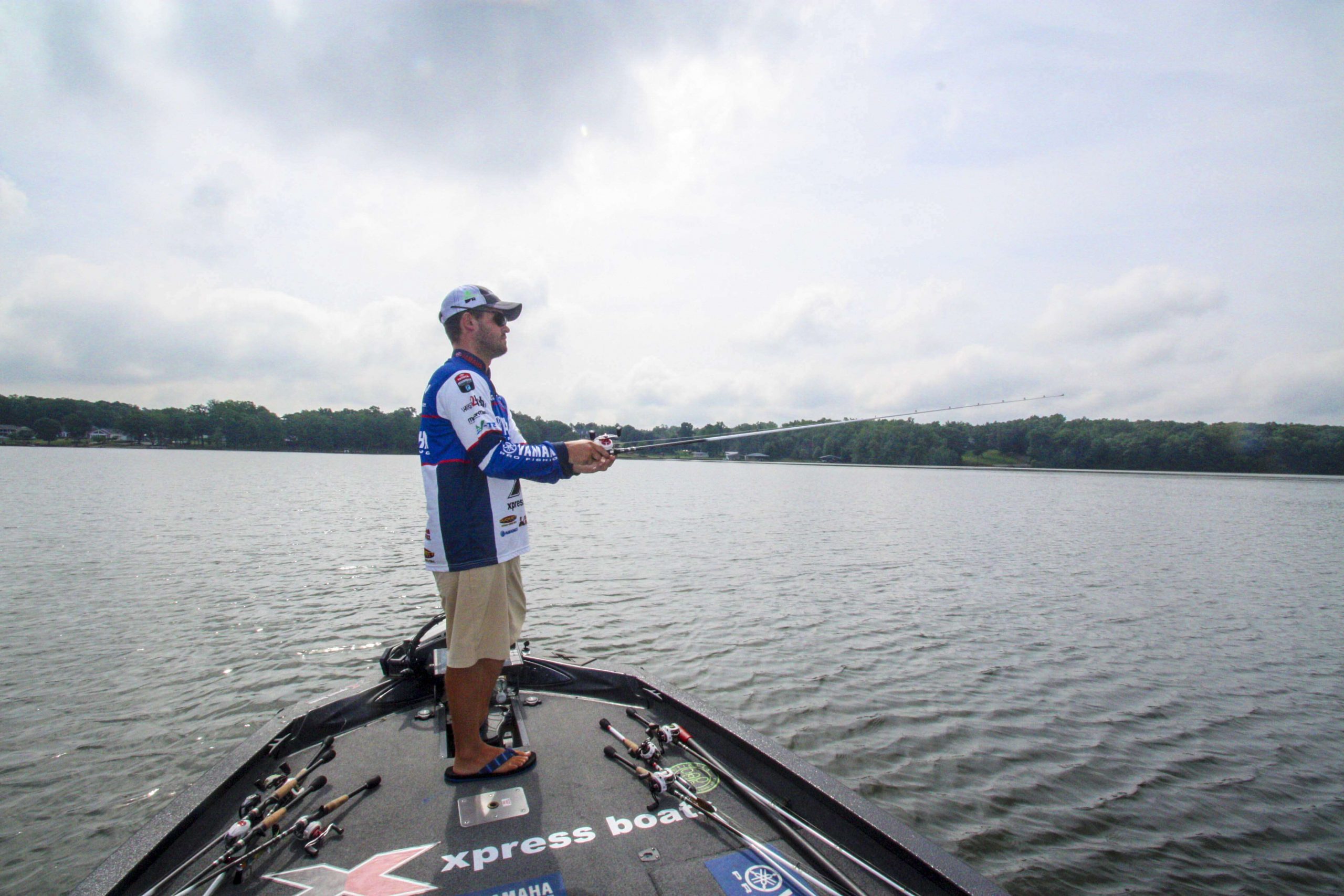
7 HOURS LEFT6:42 a.m. Hamilton and I arrive at Lake R, which is shrouded in dense fog. He pulls an assortment of Duckett rods and reels from storage. âIâm hoping to score some good fish on topwater before the fog lifts,â he says. 7 a.m. We launch the Xpress. Hamilton checks the lake temp: 80 degrees. âThe water looks stained, but itâs not muddy, so I should be able to fish a variety of lures. Most of the bass have probably already spawned, but there should still be plenty of fish up shallow. Iâm going to run uplake for starters and fish my way back down if I have to. Big bass prey on spawning bluegill this time of year, so Iâll look for bream beds in the shallows.â 7:10 a.m. Hamilton threads his way uplake through the fog to the edge of a long, shallow flat. He makes his first cast with a white and chartreuse River2Sea Whopper Plopper 130 surface lure, a âsupernoisy bait thatâs perfect for these low-light conditions.â He retrieves the big lure slowly and steadily across a shallow sand point.
All captions: Don Wirth
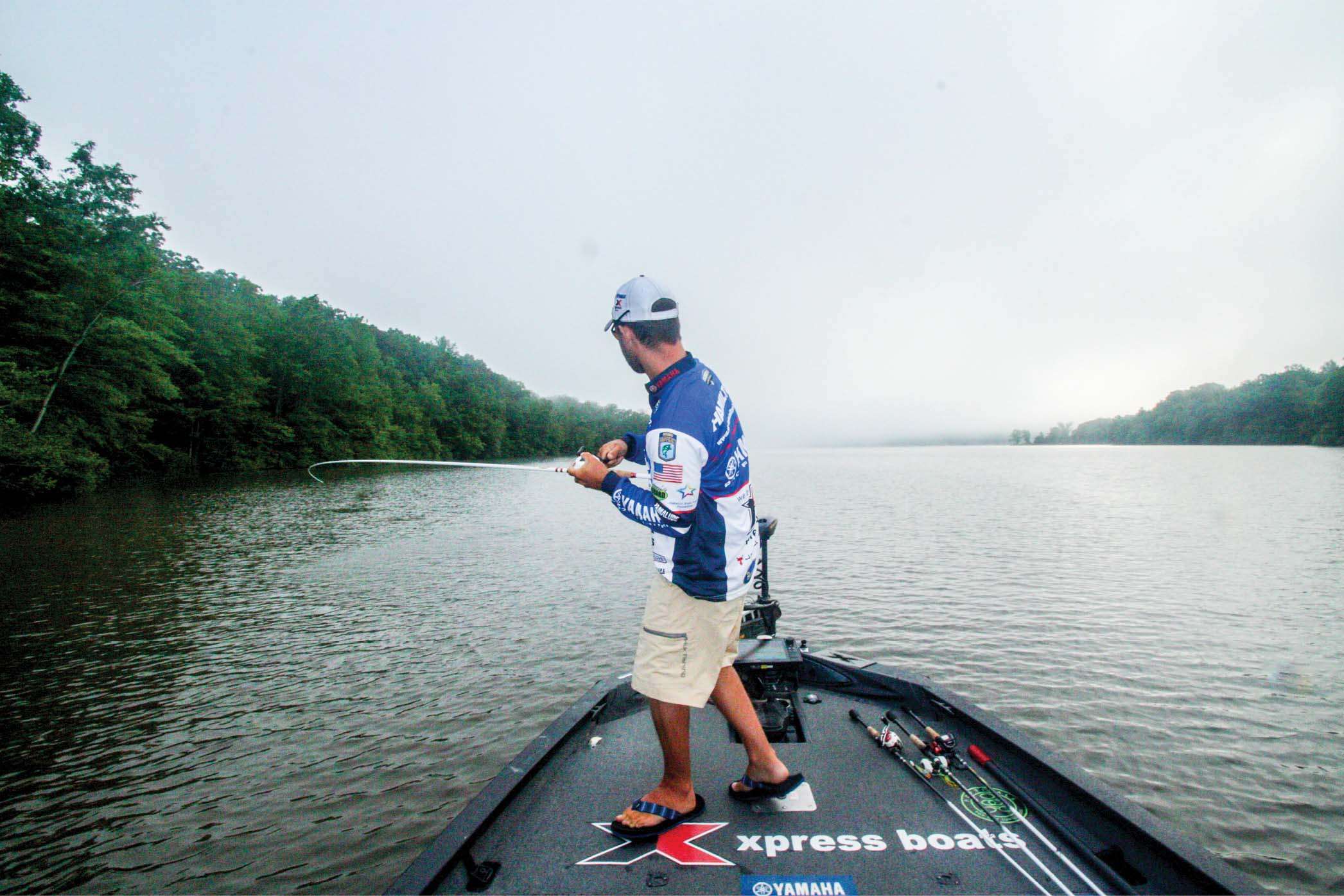
![<b>7:12 a.m.</b> âThat was awesome! Thereâs no cover on that little point that I can see; itâs just a bare patch of sand.â<br>
<b>7:13 a.m.</b> A light northerly breeze is pushing more fog into Lake Râs upper end. Hamilton switches to a bluegill colored Brianâs surface lure; it has a feathered tail, a propeller and a dished-out mouth. âThis balsa bait pops like a feeding bluegill, and you can dog-walk it. Iâve caught some whales on it during postspawn.â He casts the popper across the point. <br>
<b>7:15 a.m.</b> Hamilton switches to a green Jackall Iobee Frog and skips it beneath overhanging bushes. âIâm seeing [crater-like] bluegill beds all around the bank. There should be some bass hanging around them.â <br>
<b>7:22 a.m.</b> Back to the Whopper Plopper. Heâs fishing the noisy plug on braided line with a soft-tipped cranking rod. âThe light tip gives the fish that critical extra second to inhale the lure before you can react with a hook set.â <br>
<b>7:30 a.m.</b> Hamilton switches to the Brianâs popper. âIâm still stoked about catching that fish on my second cast!â](http://www.bassmaster.com/wp-content/uploads/2018/09/07-12_-_dotl_hamilton_2-scaled.jpg)
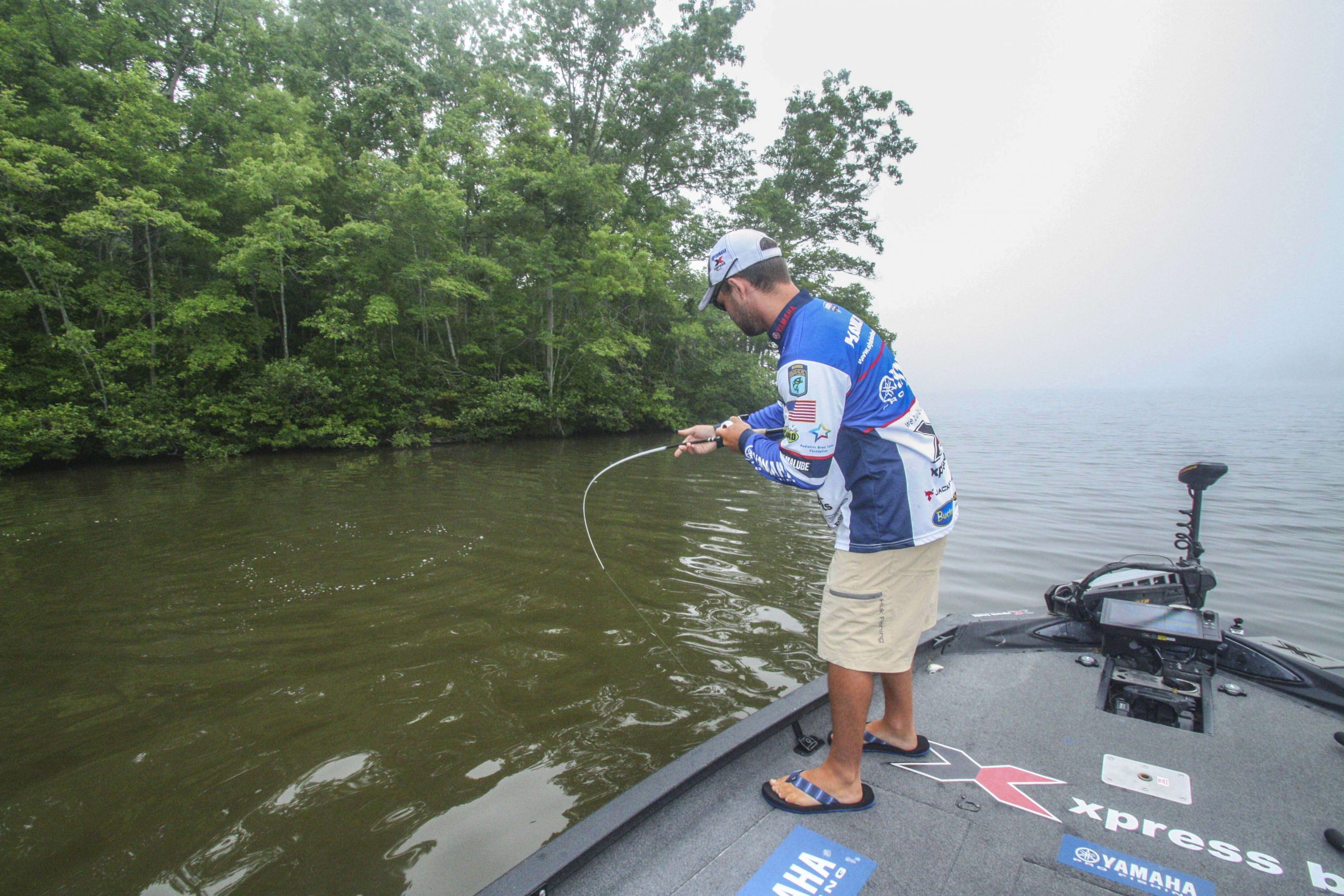
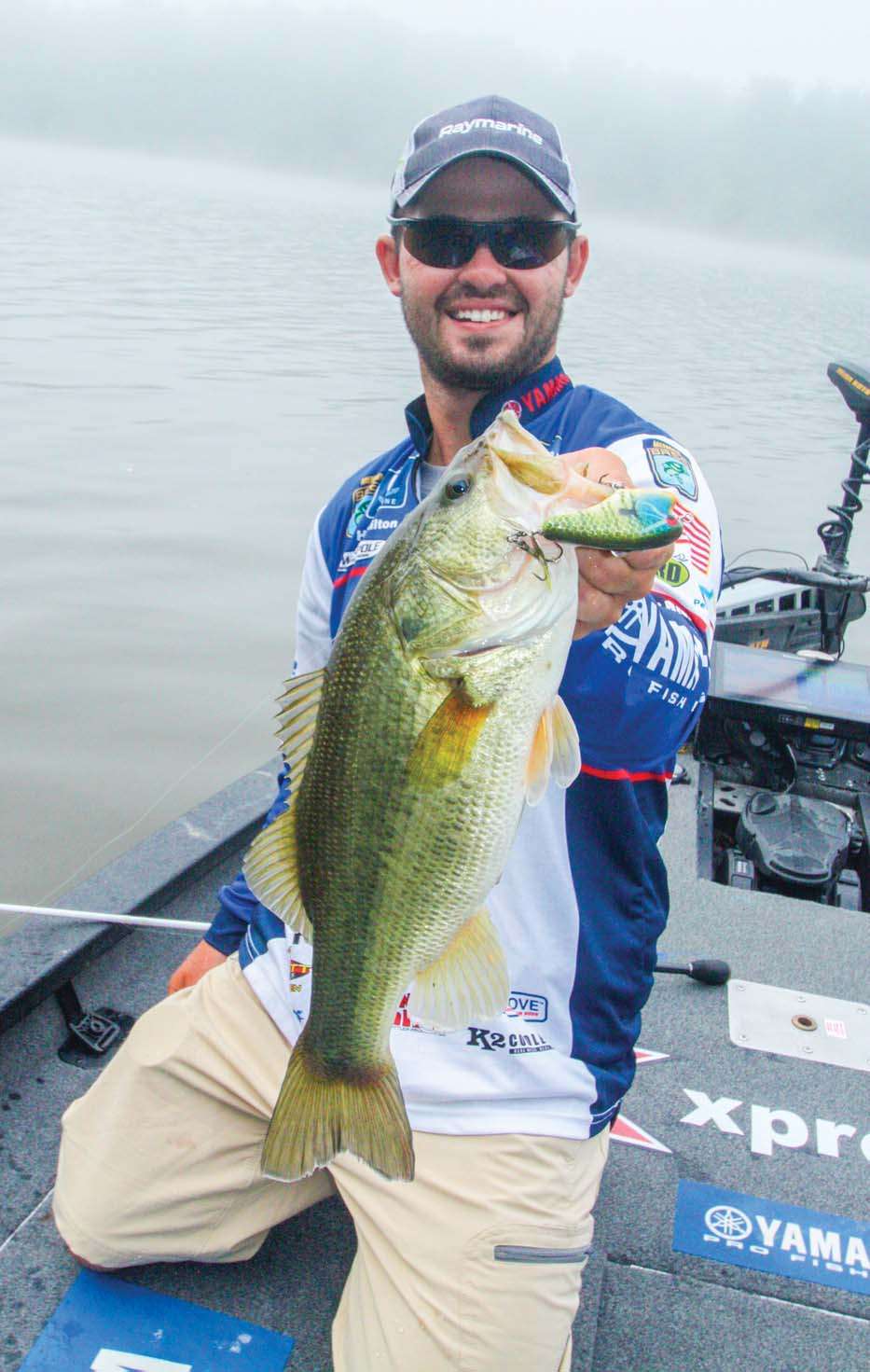
6 HOURS LEFT8:09 a.m. The shoreline turns inward to form a large pocket littered with stumps â ideal targets for Hamiltonâs topwater arsenal. 8:16 a.m. Hamilton chunks the Plopper beneath an overhanging bush. A big fish boils on it but doesnât hook up. He immediately reels in and pitches the popper to the same spot but canât coax a replay. 8:18 a.m. Hamilton lobs a jointed Jackall Giron bluegill swimbait beneath the overhang and jerks it erratically. Still no takers. 8:24 a.m. Both the Plopper and Archelon fail to elicit a strike on a big blowdown. 8:30 a.m. Hamilton switches Whopper Plopper colors to black and white. âHopefully, they can see this one better in the fog.â 8:33 a.m. Hamilton isnât thrilled with the sound of the black Plopper. âEvery one of these baits sounds different. The white one makes a deeper plopping sound; this one is higher pitched.â 8:40 a.m. A bluegill pecks the popper in another shallow pocket. âHe probably thinks itâs his girlfriend!â
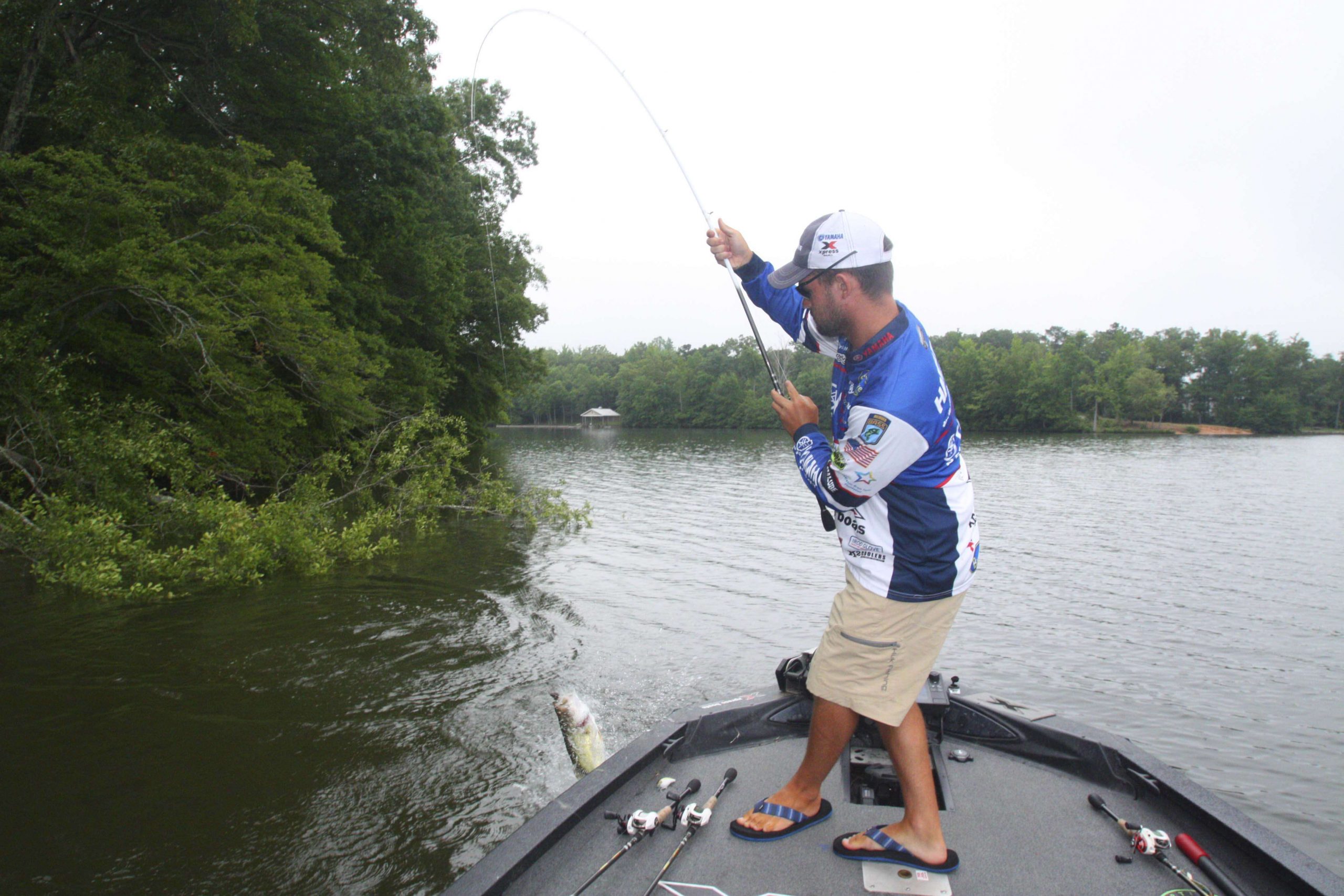
![<b>8:44 a.m.</b> âThat tree looks like it just recently snapped off and fell into the water. Never pass up a fresh blowdown; green leaves provide a lot more overhead cover than bare branches.â <br>
<b>8:45 a.m.</b> Hamilton pulls out another flipping rod; its reel is spooled with heavy braided line. âIâm [going to] rig another creature on this rod with a 1-ounce sinker so itâll drop straight down through the thicker leaves and branches.â <br>
<b>8:52 a.m.</b> Hamilton flips the 1-ounce creature rig to another tree branch, detects a tap, swings and misses. <br>
<b>8:56 a.m.</b> Hamilton enters a short tributary arm and casts the popper around laydown wood.
<p>
<b>5 HOURS LEFT</b><br>
<b>9 a.m.</b> Heâs moving slowly along the tributaryâs shoreline, alternating between the popper, frog and creature. âThereâs a little channel running along this bank. Bass should use it to travel in and out of this creek arm.â <br>
<b>9:13 a.m.</b> The fog has dissipated as Hamilton continues working shallow cover. âIâm seeing bluegill beds everywhere, but so far, no bass.â <br>
<b>9:17 a.m.</b> Hamilton pitches the popper beneath an overhanging branch. A 3-pound bass rushes it but doesnât strike. He immediately pitches the frog to the fish, but itâs disappeared. âI donât see a bass bed there. I bet it was waiting under that overhang to ambush a bluegill.â <br>
<b>9:19 a.m.</b> The bass moves back beneath the overhang. Hamilton pitches the Giron bluegill mimic to the fish and cranks it slowly, and the bass follows the lure to the boat. âGo on, hit it!â <br>
<b>9:22 a.m.</b> He pitches the creature to the fish, but itâs not interested.](http://www.bassmaster.com/wp-content/uploads/2018/09/08-44_-_dotl_hamilton_8-scaled.jpg)
5 HOURS LEFT9 a.m. Heâs moving slowly along the tributaryâs shoreline, alternating between the popper, frog and creature. âThereâs a little channel running along this bank. Bass should use it to travel in and out of this creek arm.â 9:13 a.m. The fog has dissipated as Hamilton continues working shallow cover. âIâm seeing bluegill beds everywhere, but so far, no bass.â 9:17 a.m. Hamilton pitches the popper beneath an overhanging branch. A 3-pound bass rushes it but doesnât strike. He immediately pitches the frog to the fish, but itâs disappeared. âI donât see a bass bed there. I bet it was waiting under that overhang to ambush a bluegill.â 9:19 a.m. The bass moves back beneath the overhang. Hamilton pitches the Giron bluegill mimic to the fish and cranks it slowly, and the bass follows the lure to the boat. âGo on, hit it!â 9:22 a.m. He pitches the creature to the fish, but itâs not interested.
![<b>9:26 a.m.</b> The bass wanders off, and Hamilton continues up the creek arm with the popper, frog and creature. <br>
<b>9:31 a.m.</b> Hamilton spots a big fish cruising out of a submerged tree branch. He drops to his knees and pitches the creature to the cover but hauls water. âThat was a 5-pounder!â He backs off the cover, lowers his Power-Poles and waits a few minutes for the bass to reappear, but it doesnât. <br>
<b>9:44 a.m.</b> A foot-long gizzard shad races just beneath the surface in front of Hamiltonâs boat. âIâd like to catch the bass that scared that shad! Iâm seeing a lot of smaller baitfish on my graph, too. Shallow, murky reservoirs, especially ones that donât have current like this one, often have low oxygen in their deeper areas once the water gets warm, so most of the baitfish and bass will stay surprisingly shallow. Iâm going to check some deeper areas, but Iâve had three good fish up shallow so far.â <br>
<b>9:48 a.m.</b> Hamilton works the frog around a boathouse in the rear of the tributary. âIâm amazed I havenât had a fish on that frog yet.â <br>
<b>9:55 a.m.</b> Hamilton plops, pops and pitches his way out of the tributary along the opposite shoreline without scoring a bite. He pauses to tie on a bluegill colored 1/2-ounce Buckeye G-Man Ballinâ Out jig with a green pumpkin pepper Jackall craw trailer. âGerald Swindle designed this jig; itâs got a ball head for skipping under docks.â He rigs another stick with a blueback shad Strike King 5XD diving crankbait.
<p>
<b>4 HOURS LEFT</b><br>
<b>10 a.m.</b> Hamilton makes a high-speed run to a long main-lake point. He idles around the structure, surveying it with his electronics, then cranks it with the 5XD. <br>
<b>10:12 a.m.</b> He hangs the crankbait in a deep snag, breaks it off and doesnât bother to retie. âI didnât see much activity on that structure. [Pointing] Iâm going to hit that bank over there while itâs still got some shade on it.â <br>
<b>10:31 a.m.</b> A quick pass down the shady, stump-filled bank with topwaters and the creature fails to yield a strike. Whatâs Hamiltonâs take on the day so far? âEarly morning was awesome, especially the topwater bite, but itâs slowed down now that the sunâs out. Iâm keeping an open mind about fishing offshore, but Iâll probably spend most of my remaining time flipping blowdown trees and hitting isolated wood on flats.â <br>](http://www.bassmaster.com/wp-content/uploads/2018/09/09-26_-_dotl_hamilton_10-scaled.jpg)
4 HOURS LEFT10 a.m. Hamilton makes a high-speed run to a long main-lake point. He idles around the structure, surveying it with his electronics, then cranks it with the 5XD. 10:12 a.m. He hangs the crankbait in a deep snag, breaks it off and doesnât bother to retie. âI didnât see much activity on that structure. [Pointing] Iâm going to hit that bank over there while itâs still got some shade on it.â 10:31 a.m. A quick pass down the shady, stump-filled bank with topwaters and the creature fails to yield a strike. Whatâs Hamiltonâs take on the day so far? âEarly morning was awesome, especially the topwater bite, but itâs slowed down now that the sunâs out. Iâm keeping an open mind about fishing offshore, but Iâll probably spend most of my remaining time flipping blowdown trees and hitting isolated wood on flats.â
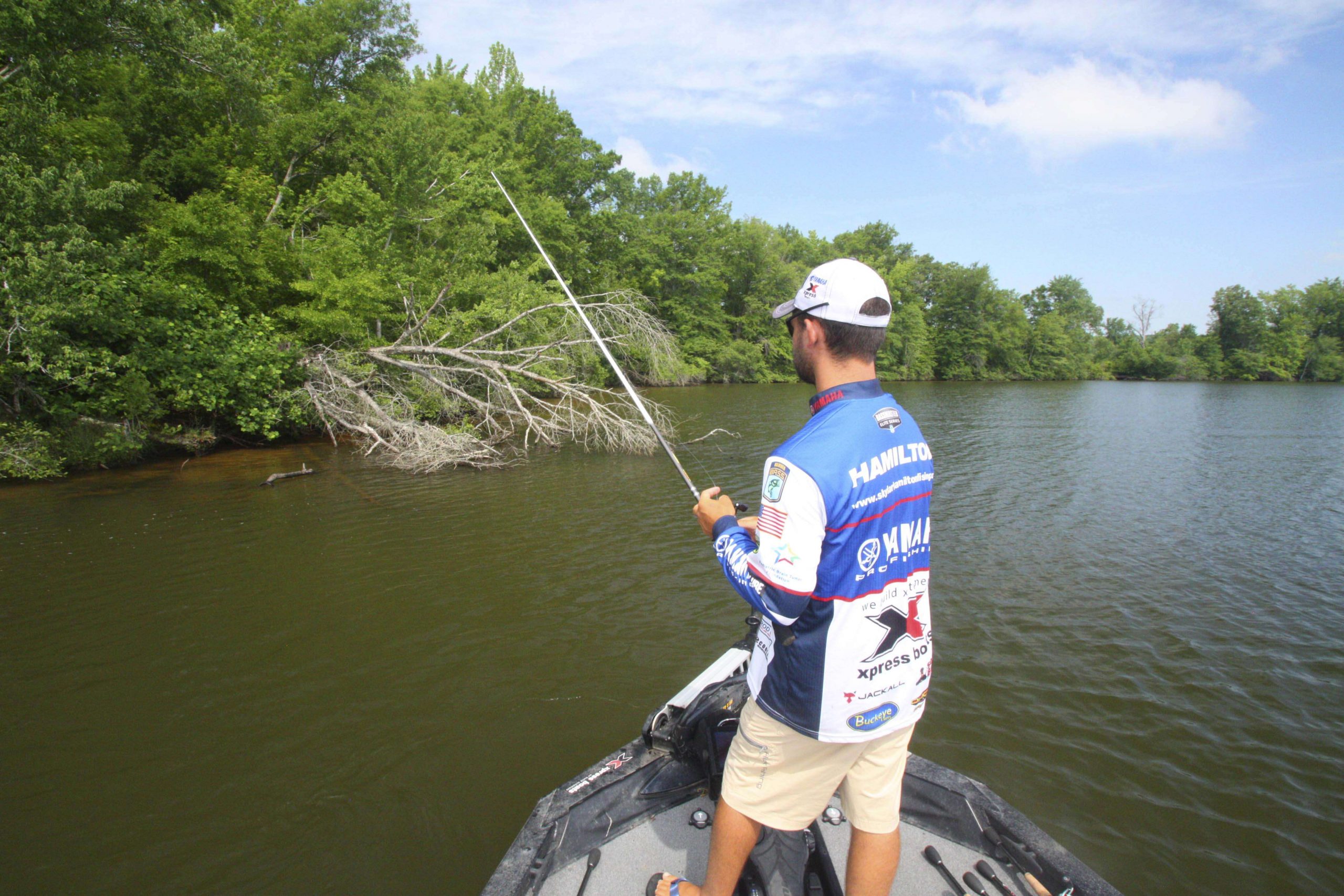
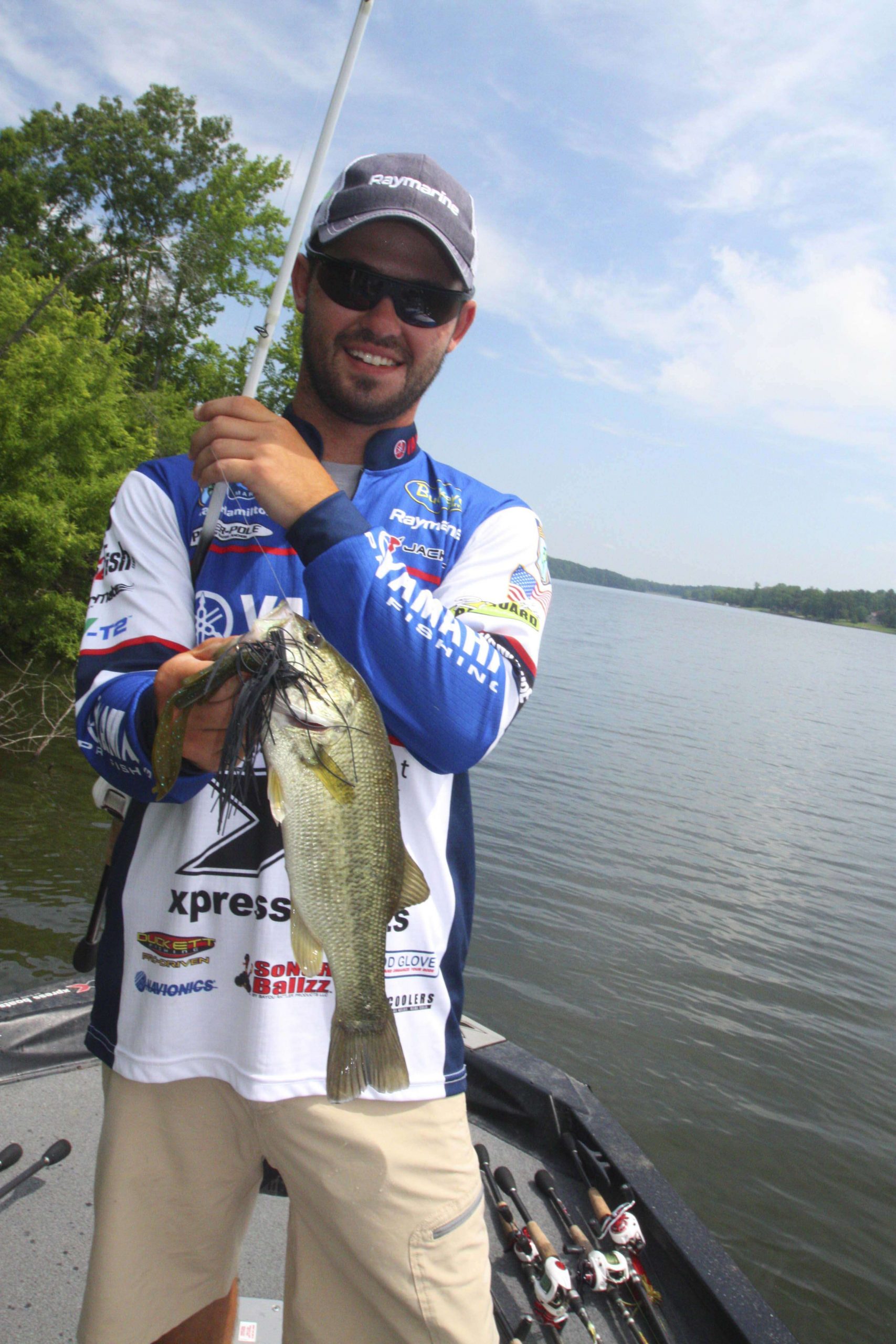
3 HOURS LEFT11:03 a.m. Hamilton is picking apart each tree he comes to with his flipping arsenal. He hits the outer branches with the 1/4-ounce creature and uses the heavier, bulkier baits to probe the thicker stuff. 11:18 a.m. Hamilton moves into a big main-lake cove and graphs up a brush-covered ledge rising from 24 to 9 feet. He rigs a plum 10-inch Berkley Power Worm with a 5/0 offset hook and 3/8-ounce sinker and casts it to the top of the snaggy structure. The wind has shifted from the north to the east.
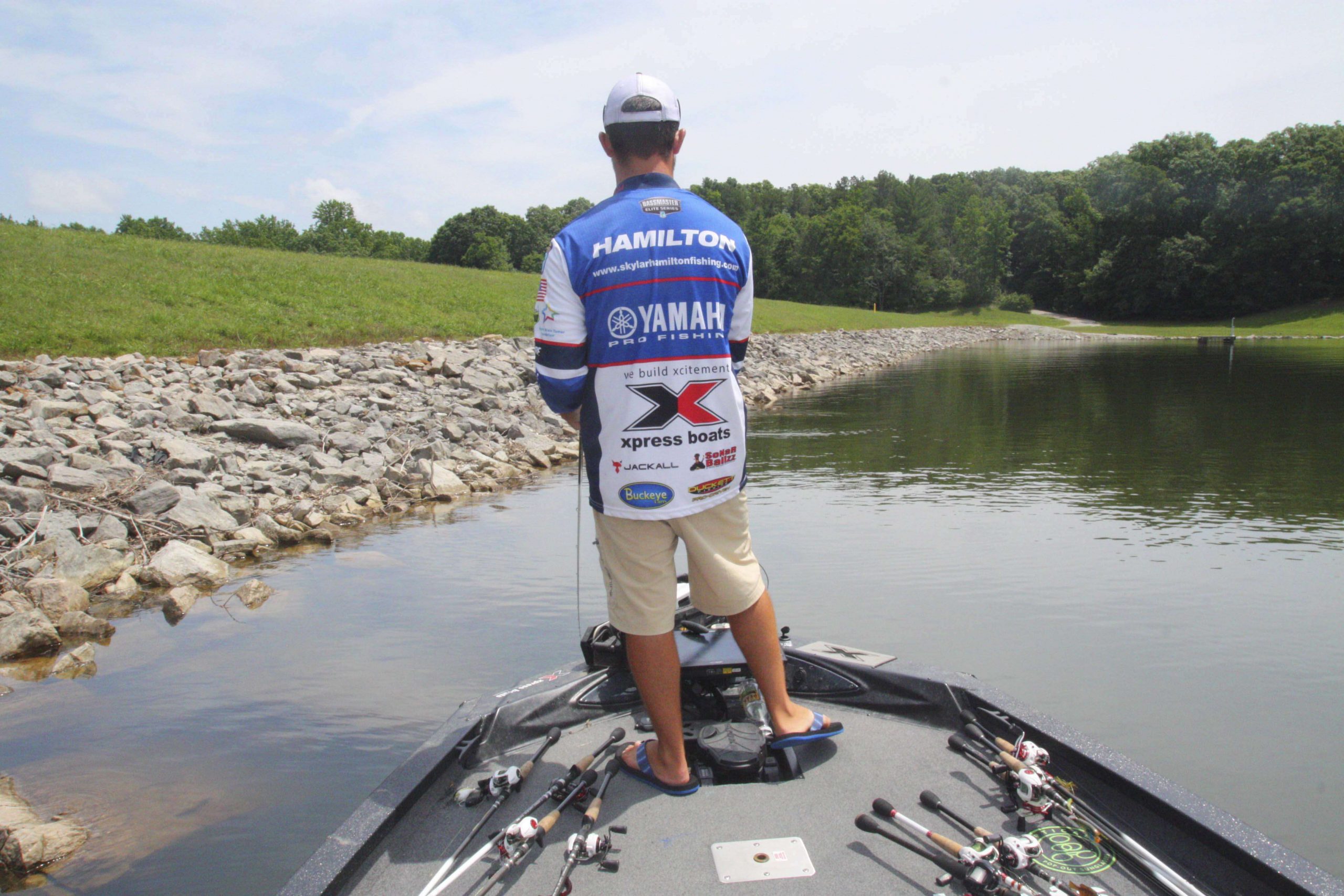
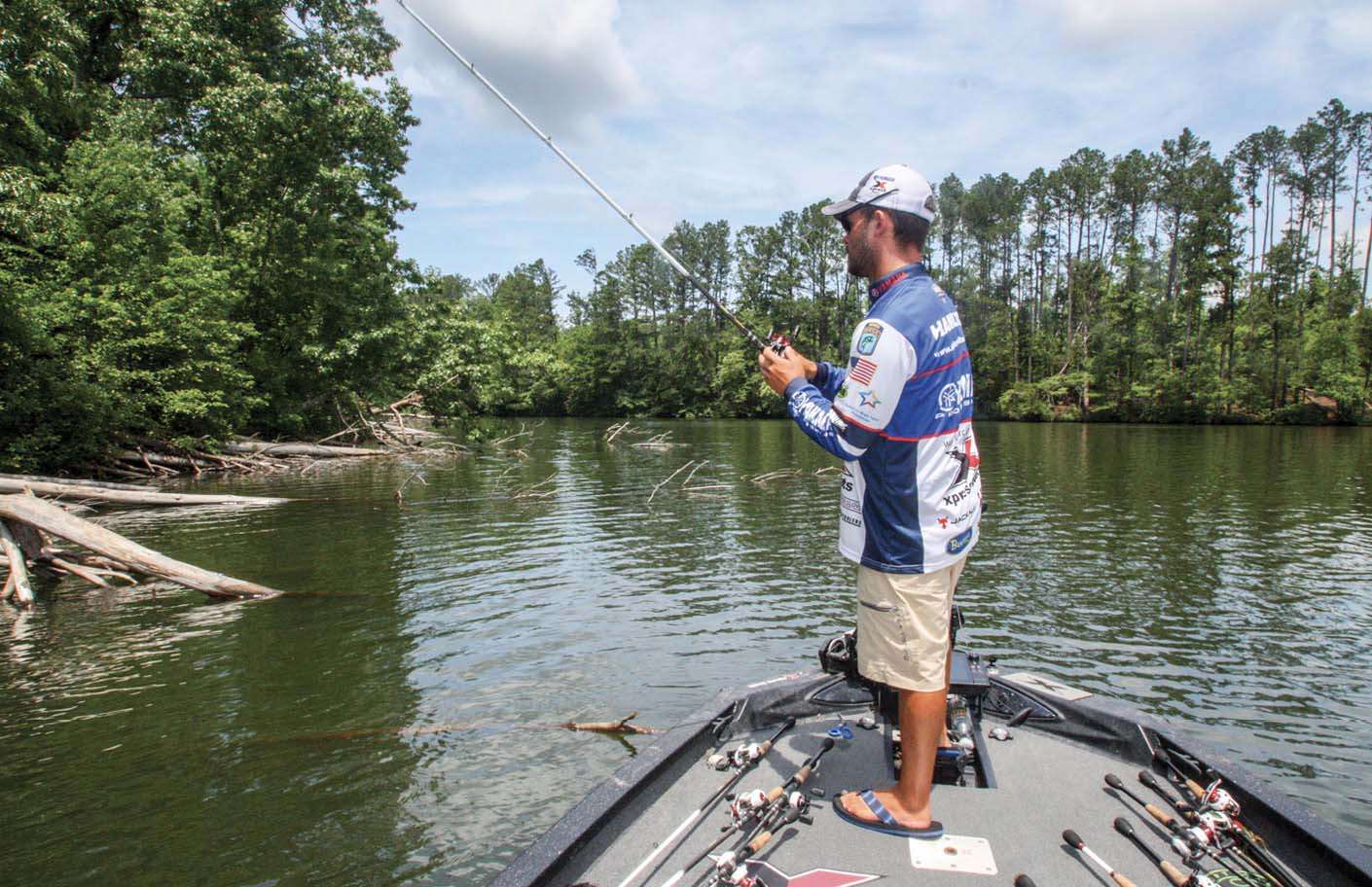
2 HOURS LEFT12:03 p.m. Hamilton runs straight across the lake to the entrance of a short creek arm. Here he flips blowdowns with the 1/4-ounce creature. 12:11 p.m. He presses deeper into the creek, still flipping tree branches. âThis lake was definitely better when it was foggy!â 12:20 p.m. Hamilton moves to the opposite bank, which is considerably steeper, and hits more tree branches with the creature. 12:24 p.m. Hamilton has reached the back end of the creek, which is shallow and loaded with big stumps. He scans the area looking for cruising bass. âI bet they spawned back here, but theyâre gone now.â 12:29 p.m. Hamilton digs through his topwater stash and pulls out a battered Rico popper with a ragged feather tail. âI call this plug Olâ Reliable! It used to be gold, but the paintâs been chewed off it.â He fires the popper beneath an overhanging tree and dog-walks it across several stumps. âIf there was one there, she wouldnât be able to stand it!â 12:40 p.m. Hamilton has blasted back uplake to the shallow flat where he bagged his first three keepers. Heâs cranking a Tennessee shad Jackall Aska 70, an upsized version of the squarebill he cranked at the dam. 12:46 p.m. Hamilton tries the black Whopper Plopper on the sand point where he caught his first keeper. 12:49 p.m. He moves farther off the bank and resumes cranking the Aska 70. 12:56 p.m. Hamilton idles uplake as far as he can go. Here, multiple schools of immature baitfish are popping on the surface, and his trolling motor is kicking up mud. He ties on a 1/2-ounce white and purple Jackall Break Blade bladed jig with a white Zoom Speed Craw trailer and retrieves it quickly through the shallows.
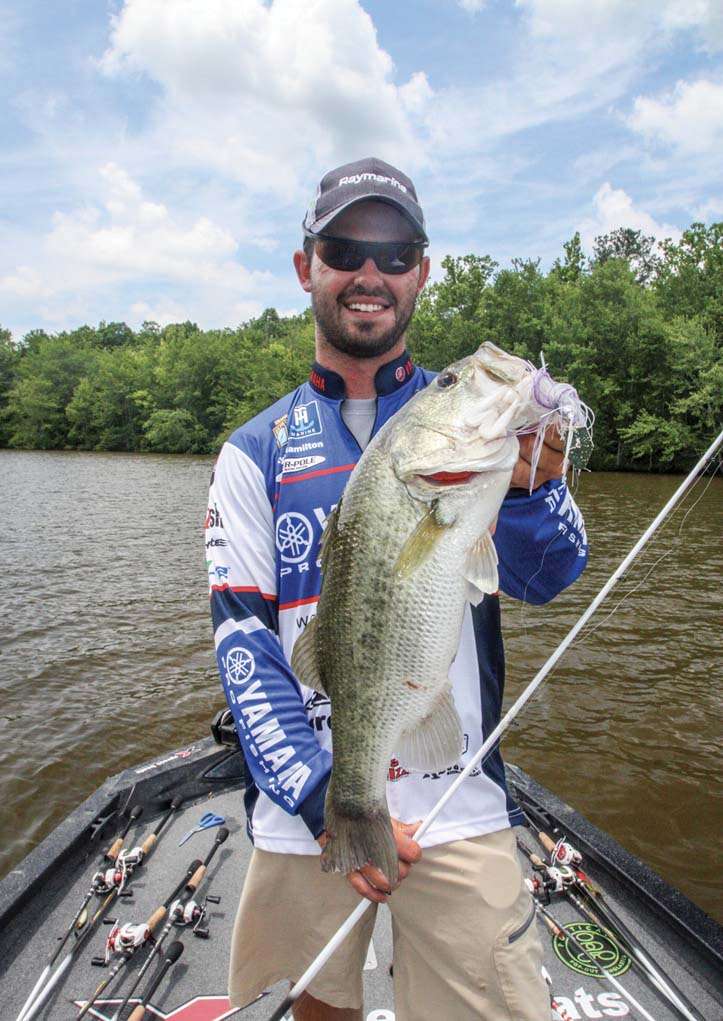
1 HOUR LEFT1:01 p.m. Hamilton gets a jarring strike on the Break Blade, but the bass comes unbuttoned. 1:03 p.m. Another bass bumps the blade bait.
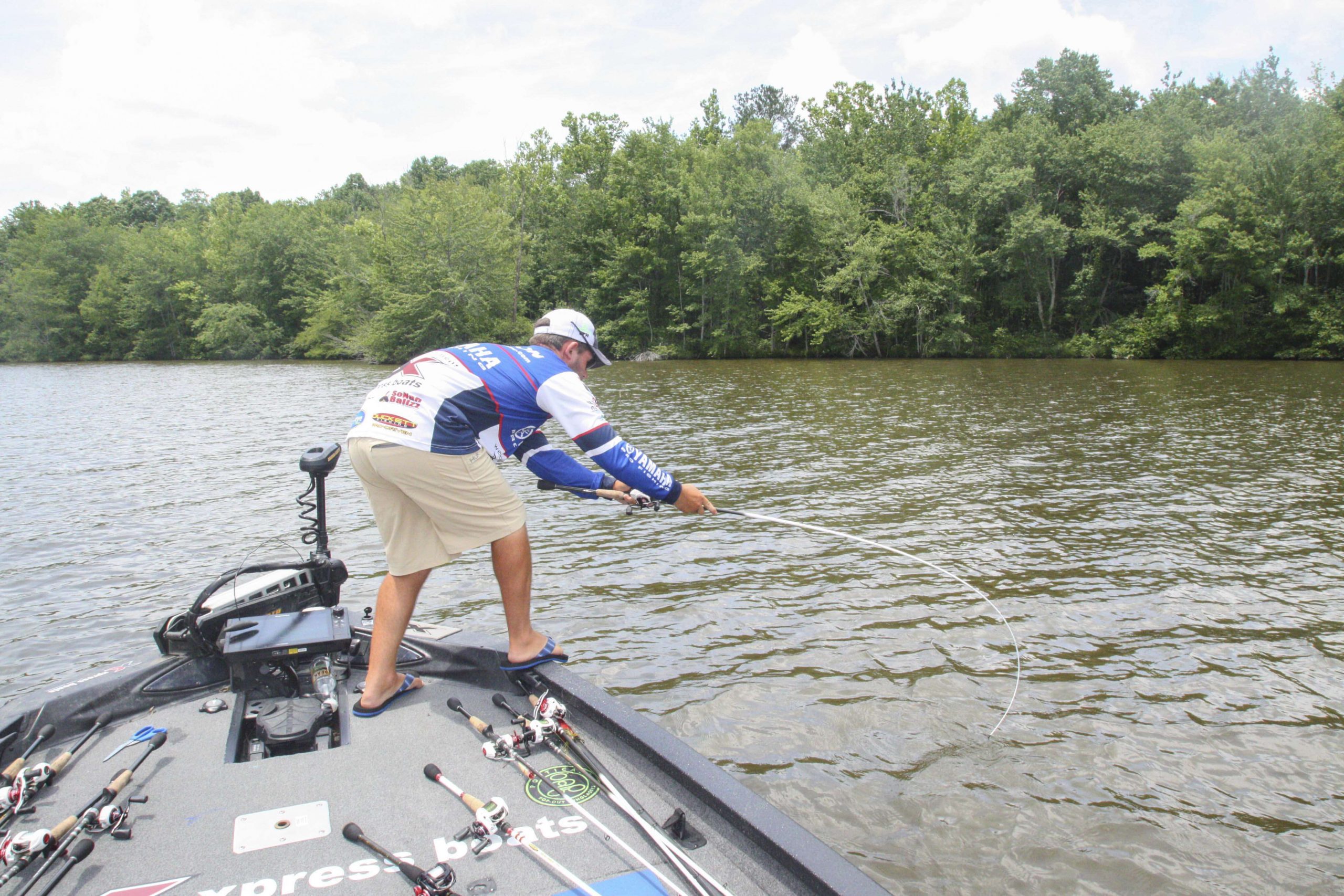
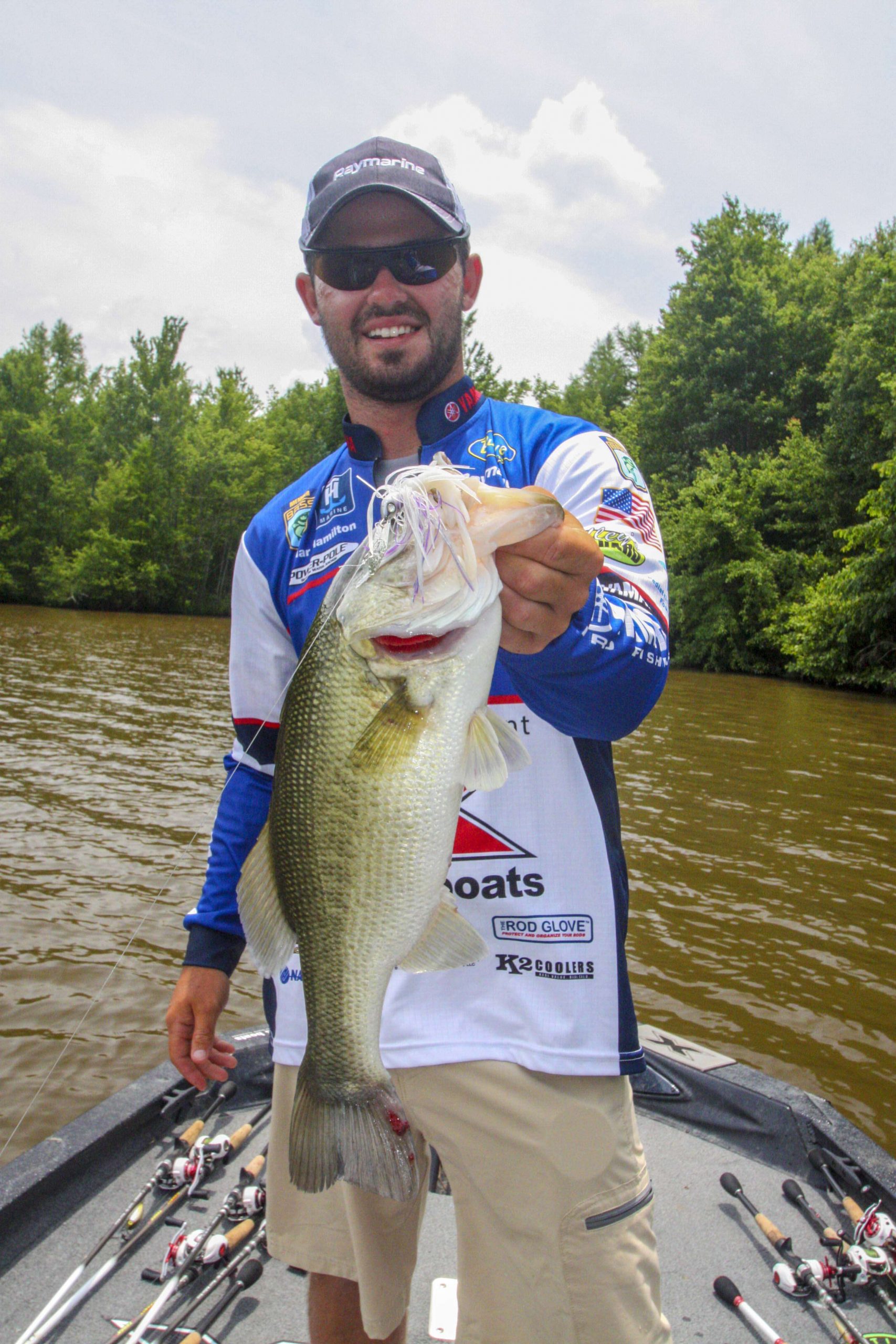
THE DAY IN PERSPECTIVE
âEvery fish I caught was in Lake Râs shallow upper end, either on a flat or in a blowdown tree,â Hamilton told Bassmaster. âThe dense fog helped the topwater bite early, then I had to flip trees once the sun got high. Spotting those baitfish schools tipped me off that the highest oxygen levels were probably in the shallows; I tried some offshore spots, but none of them produced. If I were to fish here tomorrow, Iâd launch at daybreak to maximize my topwater window, then once the sun got high, Iâd pound shallow flats and the backs of the creeks with the bladed jig and flip blowdowns.â
HIS FIVE BIGGEST BASS2 pounds, 10 ounces; sand point on shallow flat; white/chartreuse River2Sea Whopper Plopper surface bait; 7:12 a.m. 2 pounds, 12 ounces; submerged stump on shallow flat; bluegill Brianâs surface popper; 7:32 a.m. 4 pounds, 4 ounces; blowdown tree; green pumpkin pepper Jackall Archelon creature on 5/0 hook with 1/4-ounce sinker; 8:44 a.m. 3 pounds, 14 ounces; shallow isolated stickup in headwaters; white/purple Jackall Break Blade bladed jig with white Zoom Speed Craw trailer, 12:57 p.m. 3 pounds, 1 ounce; same place and lure as No. 4; 1:08 p.m.
TOTAL: 16 POUNDS, 9 OUNCES
